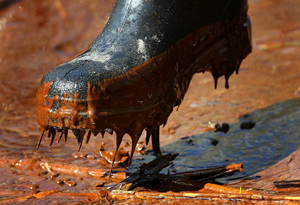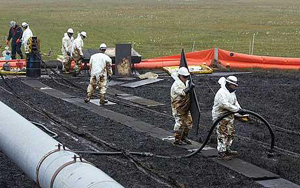BP oil spill: some lessons for Europe
on
BP oil spill: some lessons for Europe
The European Commission is studying the implications of the BP oil spill disaster for the regulatory framework in Europe. Brussels intends to come up with proposals before the summer. Hans-Jochen Luhmann, researcher at the Wuppertal Institute for Climate, Environment and Energy, has some recommendations to offer.
 |
There is one caveat, though. The National Commission does sound warnings regarding further oil exploration and production in the Arctic and in Alaskan waters, even though these warnings did not make it into the final recommendations. If enough people take the trouble to read Chapter Ten of the report, then it may not be business-as-usual in the Arctic in the coming years. For example, the report notes that ‘The remoteness and weather of the Arctic frontier create special challenges in the event of an oil spill. Successful oil-spill response methods from the Gulf of Mexico, or anywhere else, cannot simply be transferred to the Arctic.’ And: ‘Bringing the potentially large oil resources of the Arctic outer continental shelf into production safely will require an especially delicate balancing of economic, human, environmental, and technological factors. Both industry and government will have to demonstrate standards and a level of performance higher than they have ever achieved before’.
Clearly, the National Commission’s report will have implications for the European offshore industry as well. Generally, the European situation is compared favourably to the North American one. For example, the report notes that ‘From 2004 to 2009, fatalities in the offshore oil and gas industry were more than four times higher per personhours worked in U.S. waters than in European waters, even though many of the same companies work in both venues.’
Still, this does not mean that we can all sleep quietly in Europe. The amount of deepwater drilling in European (and European-Arctic waters) will grow drastically over the coming years. Just last Friday, BP (yes, the same BP) announced that it has entered into a ‘historic alliance’ with Russian state oil company Rosneft to explore and develop three large blocks on the Russian continental shelf, with a
| The fact is that, even in the North Sea, a generally shallow body of water, there are three sites where drilling is planned at a depth of over 1,000 meters |
Implications for offshore production in Europe
The disaster in the Gulf of Mexico (GoM) has two distinctly different features:
- the incident in the Macondo field itself, which was initially an industrial accident affecting victims on the rig, but then, with the spillage of oil and other pollutants, turned into an environmental disaster, with consequences for animal and human habitats;
- the fact that it took so long for the problem to be resolved, a dismal performance by the powers-that-be that may have done little to affect the long-term standing of the oil industry but has severely damaged the reputation of the President and the ruling party in the US.
The political fallout did not go unnoticed by the European Commission. On 12 October 2010, the Directorate-General for Energy (DG Ener) issued an official communiqué on offshore oil and gas activities. The EU appears willing to draw some lessons from the turmoil far away in the Gulf of Mexico
| Coverage is limited to a maximum $120 million dollars per incident. In light of what has happened in the Gulf, this is too low by a factor of 100 |
1. The advance of the offshore industry into greater and greater depths is unstoppable, even off the coasts of Europe.
The trend is towards greater water depths. This is a classic ‘new frontier’ scenario. The fate of the Deepwater Horizon rig is a stark indicator of where the oil and gas production industry is inevitably headed. But the phenomenon is not unique to the US; it is a global development that is also taking place off European shores.
The fact is that, even in the North Sea, a generally shallow body of water, there are three sites where drilling is planned at a depth of over 1,000 meters: west of Scotland at 1,600m and off the coast of Norway at up to 1,700m, i.e. both deeper than the Macondo field. Last year, Exxon drilled wells off the coast of Libya in water depths of 1,500 and 2,000 metres. Likewise BP. And somewhere off the coast of Egypt, Statoil is planning a well in 2,700 metres of water.
Deepwater drilling is now also coming to the Black Sea, a body of water where depths of 100 metres have traditionally been the norm. Romania has issued a licence for a field 1,000 metres below the surface, while Turkey is looking to exploit deposits at more than 2,000 metres in depth.
The unprecedented feature of the GoM disaster, namely its long duration, was specific to the depth at which it occurred. The limit at which divers can be deployed to rectify an unforeseen occurrence is around 200 metres. Beyond that point, robots have to be used, which creates a qualitatively different risk scenario. However, the Commission did not go as far as formulating this in explicit terms.
 |
| Photo: Oil Spill News |
It seems that the Commission’s priority for now is to reduce the danger of self-inflicted injury to the oil and gas extraction sector – which is seen as playing a vital role in our modern transport system – and, by association, to maintain political legitimacy for itself. Any possible impact on the environment itself is seen merely as a contributory factor in reducing public confidence. The ambivalence in the way the problem is defined and which so clearly permeates the official statement is to be understood in the context of these motives. This approach is clearly inadequate.
2. The parlous state of collective coverage for liability obligations
There is cause for concern about the size of funds set aside to cover any eventuality. The lesson of Deepwater Horizon is that, as the industry ventures ever further into deeper waters, it is also entering a completely new financial dimension.
The current regulations governing the OPOL liability pool (Offshore Pollution Liability Agreement) set up by the oil and gas offshore industry were first drawn up in September 1974, since when they have not even been adjusted for inflation. Coverage is limited to a maximum $120 million dollars per incident. In light of what has happened in the Gulf, this is too low by a factor of 100. Moreover, OPOL is restricted solely to the consequences of oil spillage.
A possible benchmark could be the regulations applying to nuclear power plants and, more recently, CCS reservoirs, where the level of insurance cover required has since been precisely defined. But even here, there is a certain lack of explicitness on the part of the Commission.
3. A risk that is specific to the North Sea – gas under high pressure
Even where its waters are relatively shallow, the North Sea is also subject to a risk that is paralleled in the Deepwater Horizon accident. The Commission writes: Despite lesser drilling depths in Europe, the risks are often similar … [to those encountered in the Macondo field] … , as a number of fields are characterised by high pressures.
This is a reference to what happened in European waters 20 years ago when there was a massive blow-out off the coast of Scotland. The British subsidiary of the Mobil Corporation was drilling for oil
| There should be no trade-off between the obligation to tell the whole truth and the added costs that arise from doing so |
4. Gas emissions - limited obligation to tell the truth
The only gas escapes deemed worthy of reporting are those of methane. However, as ‘any schoolboy’ can tell you, fossil deposits of hydrocarbons by definition contain not only oil but also natural gas (CH4); also fossil CO2, insofar as the highly desirable hydrocarbons are stored in carbonate-rich geological formations. Oil and potent greenhouse gases thus inevitably go hand in hand. If there is a blow-out wile a well is being drilled, they will tend to gush forth in combination. What we see, however, is an exclusive focus on the amount of oil discharged, an approach that is also adopted by the Commission in their official communiqué. I would contend, however, that in case of future accidents, accompanying spills of substances and gases, especially of greenhouse gases should be reported in full. There should be no trade-off between the obligation to tell the whole truth and the added costs that arise from doing so.
To ensure that these environmental risks are properly addressed, what should happen is that DG Climate should take the lead in formulating regulations rather than DG Energy, as is currently the case. But it is a moot question whether Energy Commissioner Günther Oettinger would be prepared to abandon his claim to sole spokesmanship rights in the broader interest.


Discussion (0 comments)